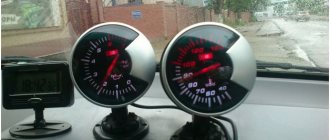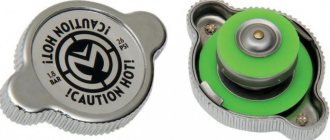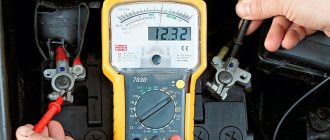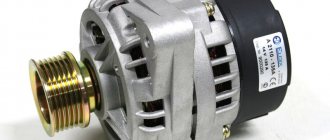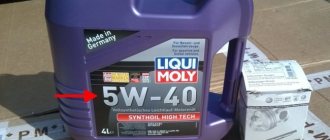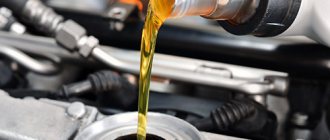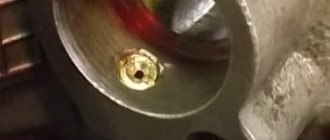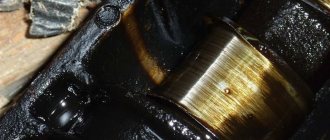How to adjust oil pressure in a 402 engine
mileage 90 thousand native
mileage 90 thousand native
But I completely agree with this.
Z.Y. I currently have Shell 10w-60 in it.
Regarding the oil, YES there was a mistake, I was wrong (I was completely confident that I filled my tired engine with 20w30). I REPENT, I looked and this is what I found, maybe it will be useful to someone. Choose the right oil for your engine
Choosing oil for your car is quite difficult. MOTUL offers a simple solution to help you make the right choice. Now you will know everything you need from the concepts of all-season use and technosynthesis to ratings.
When selecting engine oil, it is most important to follow the manufacturer's recommendations for the oil viscosity grade, grades, and specifications required for best engine performance. Recommendations contain all the necessary information on products and distributors.
For further guidance in understanding the properties of oils that determine performance levels, below is all the information you need to know.
The secret of all-season oils
All oils for car engines are multi-season (10W-40 / 15W-60 / 5W-30). Without getting too technical, this is the most important property of the oil and the only thing that determines where it is used. Before using multi-season oils, the seasonal oil must be changed according to the season. Since oil liquefies gas depending on engine temperature, it is very important to accurately determine the viscosity grade (SAE).
There are two viscosity grades: from 0W to 25W for low temperatures (the letter W stands for Winter) and a summer viscosity grade, which can range from 20 to 60. The winter grade includes the properties most important for starting a frozen engine, while the summer grade The viscosity grade is intended for normal operating temperatures.
Thus, multi-grade oils offer a wide range of uses for various engine operating conditions.
For example, 5W-30 and 15W-60 do not have the same characteristics, so car manufacturers specify a viscosity grade that is perfect for each engine. It is very important to follow these recommendations.
SAE, API SH/CF, CCMC G-4, PD-2 and G-5/PD-2 are categories established by independent organizations. For example, the acronym ACEA stands for "Association of European Automobile Manufacturers", while the "American Petroleum Institute" is known as API. The categories precisely classify oils according to various properties such as anti-wear, anti-oxidation and anti-corrosion.
Automotive manufacturers set strict criteria for selecting motor oils and determine ratings based on their ability to meet technical needs. MOTUL oils have been approved to meet the latest and highest requirements.
Synthetic, Technosynthese®, Mineral
The composition of oils is important in determining the characteristics and quality of the oil. Originally, motor oils were obtained from refined fuels - so-called mineral oils. Under the pressure of modern technology, the creation of synthetic oils consisting of several components has opened up new possibilities. These synthesized products have significantly improved performance and are of exceptional quality. Further research led to the creation of Technosynthese® technology, which made it possible to combine the qualities of synthetic and mineral oils.
You can drive a sport car with mineral water and a used car with synthetic water, if you choose the right viscosity *at operating temperature*!! But! If you buy mineral water (semi-synthetic), then with these characteristics you will only find 20w50. The first number should be scary here, cold viscosity. The thicker the oil when cold, the longer the oil starvation will occur when the engine starts. But 5w50 synthetics are quite easy to find on sale. And only synthetics can be so liquid when cold and maintain the required viscosity at operating temperatures. The point is just in the temperature range, here synthetics rule. Well, the replacement interval and cleaning properties, of course.
Source
How to increase engine oil pressure 402
| Page 1 of 5 | 1 | 2 | 3 | 4 | 5 | > |
Symptoms
On a cold engine, even at idle 3 atm, on a hot engine at idle the light blinks. And if the temperature reaches 90, it lights up completely. It only goes out when the gas is applied. This never happened before; 2-3 atm at 2000 rpm was even on a slightly overheated engine. We removed the pump, saw a stuck pressure relief valve (previously, on a cold engine, the pressure simply went off scale), and pulled it out. The pump has some play, the gears seem to be intact. They put it back together and stuck it back in. Now when it’s cold the pressure doesn’t go off scale (4-6 when on the gas). And when it’s hot, the light comes on again. Where to dig? What to do? Motor ZMZ-402, mileage 65,000 km. And yes, while the pressure relief valve was “stuck”, it leaked from under the packing
Which I guess. 1. We installed a worn-out oil pump in vain. It was necessary to change it and it was done. 2. Some kind of glitch in the oil cooler system. How is the valve arranged? If he is. I read somewhere that on Volgas the automatic oil pressure valve is located in the oil filter housing. There is also a ZMZ-402 here - maybe there is a problem with it?
The problem of the UAZ-3151x oil cooler with the ZMZ-402 engine As is known, the main problem for which it is problematic to use an oil cooler is a significant decrease in pressure in the oil line at idle speed (up to the warning lamp coming on) when the engine is well warmed up.
Why is this happening? I considered it correct to look for the answer in the official literature.
In the book “Car Design” (V.P. Perederiy, Textbook, 2006) the following is said about the oil radiator: “The required oil temperature (80-110 degrees C) is maintained using two systems - cooling and lubrication, the operation of which is closely related between yourself. Oil radiators are similar in design to tubular-plate radiators of the cooling system or are made of finned tubes. Oil is pumped through the radiator either by an independent oil pump (section), or taken from the main line fed by the main pump through a nozzle. The section of the pump supplying oil to the radiator is equipped with a bypass valve adjusted to excess pressure (0.12 MPa). If the radiator is powered by a common pump, then a safety valve is introduced into the lubrication system, which turns off the radiator when the pressure in the system drops to 0.1 MPa.” If we take into account that the ZMZ-402 has a system with a single oil pump, then according to “science” there should be an additional valve in its oil line to prevent a pressure drop below the minimum permissible. In the given picture from the book “Engine of the GAZ-3110 Volga” (Kalashnikov A.A., 1999), this valve is visible (Fig. 1-20), in the picture for the same engine, but from the Operation Manual for the UAZ- 3151x (Fig. 2) there is no valve.
Fig. 1 Diagram of the ZMZ-402 lubrication system on the Volga car:
1 — oil pump inlet pipe; 2- pressure reducing valve; 4- hole for draining oil; 5- pointer sensor; 6- oil line; 7 — hole for supplying oil to the gears of the oil pump; 8 - helical groove; 9 — tube for lubrication of timing gears; 10 — groove on the first journal of the camshaft; 11 — oil filler cap; 12 — channel in the crankshaft; 13 - plug; 14 — bypass valve is closed; 14a - bypass valve is open; 15 — channel for supplying oil to the rocker axis; 16 — filter element; 17 — plug for draining sediment; 18 — hole for spraying oil; 19 — emergency oil pressure lamp sensor; 20 — oil radiator valve;
21 — oil radiator shut-off valve; 22 — oil pump; 23 - plug; 24 - oil level indicator
Fig. 2 Lubrication system ZMZ-402 on a UAZ vehicle
1.11 — hoses; 2 - air filter; 3 - filter element; 4 — rocker cover; 5 - oil filter; 6 — oil pump with oil receiver; 7 — engine crankcase drain plug; 8 - oil radiator; 9 — oil radiator shut-off valve; 10 — oil pressure indicator sensor; 12 gauge crankcase ventilation hole
From both figures one can also notice one significant point: in the Volga diagram, oil is taken into the radiator before the filter, while in the UAZ diagram it is after. This means that in the Volga circuit, the filter does not waste its limited capacity on cleaning the oil, which, after passing through the radiator, is drained back into the sump. Thus, in the Volgov circuit, in contrast to the UAZ circuit, due to the reduced load on the filter, the opening moment of the oil filter bypass valve is delayed as much as possible, i.e. the moment when crude oil begins to flow into the line (Fig. 1-14a).
For the practical implementation of the Volgov scheme on a UAZ with a ZMZ-402 engine, four additional parts will be required:
Oil cooler valve assembly (63-1013095).
Fitting (24-1017395) - is placed in place of the bolt fitting, and the valve is screwed into it.
Inlet hose* is a long hose that connects the radiator to the valve through a tap.
Oil radiator (3102-1013010-02) is a five-row radiator with inlet and outlet from different sides.
* Initially, it was planned to use an inlet hose from Volga (3110-1013100), but instead a longer “Fuel Hose - UAZ 1-piece 1400 mm” was purchased, which, among other things, turned out to be more sophisticated in design and cheaper.
First, the side shields and standard oil cooler were removed. Brackets were needed from the latter, since the Volga radiator is five-row, which is why its original brackets are shorter and will not fit in place. Since the alternation of rows occurs at the same interval on both radiators, the coil of the Volgov radiator fits normally into the brackets of the standard oil radiator.
Now it's the valve's turn. But first we had to remove the bolt fitting, for which we had to remove the lower shield. When the bolt fitting was removed, I discovered that the radial holes in the bolt fitting and the valve fitting were different and were 9 mm and 6 mm, respectively. After thinking a little, I drilled holes in the new fitting and chamfered it in the same way, this was done on the standard fitting bolt. After that, having screwed the valve into the fitting, I put this assembly in place (making sure that both sealing washers are in place), stretching it so that the seat under the faucet was conveniently directed (forward at 45 degrees). Having disassembled the standard outlet assembly, I received a faucet, sensor and hose. The tee now turned out to be an extra part. The faucet was put in place - in the valve, and turned so that access to it was convenient (with the handwheel backwards, across the machine). A new long hose was screwed into the faucet itself. On the other hand, an oil pressure sensor was screwed into the resulting threaded hole (as in Fig. 1-5). Now it's time to connect the hoses to the radiator. The new long hose turned out to be too long and half a meter was cut off from it (the remaining part was less than a meter), after which the hose was laid along the radiator mounting rod and secured to it with ties. The outlet hose turned out to be short, so it had to be replaced with a longer inlet hose (connected to the tap according to the standard circuit). The side panels were installed in place, and the hoses were placed in the niches.
Oil pressure ZMZ 402
The technical condition of the engine is constantly changing during operation.
During the break-in period (about 2000 km), as the rubbing surfaces run in, friction losses decrease, engine power increases, fuel consumption decreases, and oil waste decreases.
Next comes a period in which the technical condition practically changes little.
As parts wear out, gas breakthrough through the piston rings increases, compression in the cylinders decreases, oil leakage through the gaps in the joints increases and the pressure in the system drops.
Consequently, engine power gradually decreases, fuel consumption increases, and oil consumption increases.
Determining the technical condition of the engine for timely restoration repairs is very important.
This will extend the overall service life of the engine and prevent emergency engine failure.
The condition of the engine is assessed by instrument indicators (coolant temperature and oil pressure), the nature of engine operation in various modes (uniformity, noise quality), the amount of compression in the engine cylinders, and the vehicle’s reaction to changes in fuel supply with the accelerator pedal. A drop in engine power is manifested in a decrease in the dynamic qualities of the car and a deterioration in throttle response.
The car accelerates sluggishly, has difficulty climbing hills (you have to downshift prematurely), and does not reach maximum speed.
It should be borne in mind that these symptoms may also be the result of a violation of the adjustment of the vehicle’s chassis mechanisms.
The free rolling distance (coasting) of a serviceable vehicle, with a full load, moving at a speed of 50 km/h, must be at least 550 m.
This test is carried out in calm weather on a dry horizontal section of a highway with an asphalt or concrete surface.
Fuel consumption (operational) depends not only on the technical condition of the engine, but also (if the vehicle's chassis is in good condition) on road conditions, load, and driving methods, therefore operational fuel consumption is not an objective indicator of the technical condition of the engine. The technical condition of the engine (if other vehicle mechanisms are in good working order) is determined by the control fuel consumption when driving a fully loaded vehicle along a horizontal section of a highway with asphalt or concrete pavement at a speed of 60 km/h.
Low oil pressure on ZMZ-402
May 10, 2011, 21:56 #1
good day everyone! I have this problem, can anyone tell me, I got caught on the Volga ZMZ402, the block burst, installed another one (pig in a poke), started the oil pressure at cold 3.2, warmed up 0.4, is it possible to increase the pressure without spending a lot of time and money so that the engine can at least live month and is it really possible to change the liners without removing the piston from the car BIG MERCI!
May 10, 2011, 10:15 pm #2
2-remove the head, knock down the tie rod, remove the cushions, jack up the engine. behind the clutch housing, the pan will be removed. further it is clear. The cartridges sometimes turn sour and come out poorly; a mandrel is needed. If you decide to remove the knee, it’s easier to remove the motor. 1-rep. change the oil pump.
May 10, 2011, 10:19 pm #3
skorikoffx199xp, May 10, 2011, 21:56
good day everyone! I have this problem, can anyone tell me, I got caught on the Volga ZMZ402, the block burst, installed another one (pig in a poke), started the oil pressure at cold 3.2, warmed up 0.4, is it possible to increase the pressure without spending a lot of time and money so that the engine can at least live month and is it really possible to change the liners without removing the piston from the car BIG MERCI!
I had the same problem with oil pressure. Even thoughts appeared about dead liners, major repairs, etc. A friend advised me to change the pressure sensor. They, he said, are short-lived. I changed it and the pressure shows below three only in the summer when it’s hot and when you drive for a long time (but not less than two). Try changing it, it costs up to 200 rubles. Maybe that's the reason?
May 10, 2011, 11:40 pm #4
Thank you! Tomorrow I'll try all the options and see what happens, I'll write to a friend who might find it useful
Lada Niva 2131M Nissan Patrol
May 11, 2011, 06:36 #5
Removing the engine and changing the piston is much easier and more convenient than squirming under the car and jumping in and out of the hole all the time, you will suffer more. And why only for a month?
May 11, 2011, 20:02 #6
skorikoffx199xp, May 10, 2011, 21:56
good day everyone! I have this problem, can anyone tell me, I got caught on the Volga ZMZ402, the block burst, installed another one (pig in a poke), started the oil pressure at cold 3.2, warmed up 0.4, is it possible to increase the pressure without spending a lot of time and money so that the engine can at least live month and is it really possible to change the liners without removing the piston from the car BIG MERCI!
I had to change the liners, pistons with rings on the M-412. At the same time, the crankcase was not opened. The cartridges were “swinged” and lifted. I “twisted” my fingers using a hairpin and a wrench. There was no question about quality repairs. The task was to reduce oil consumption (1.0 L per thousand), and as they say - how much is appropriate. The crankshaft was “young”. Oil consumption, due to new rings, has decreased sharply. The rest is all with a hundred thousand mileage. 17 thousand passed without any comments, then I don’t know, I put it to work (IH 2715 - a pie, a heel), I saw it on the go for three years.
Renault Megane Extreme
May 11, 2011, 20:11 #7
Its oil pressure is low, what does the piston have to do with it? Grind the main journals to the repair size and install new liners, although the sensor may really be lying or the crankcase oil intake is clogged with dirt.
Source
Recommendations
Comments 54
XPEHOV maybe the oil was expelled first and then the liner turned
if the breather smokes, throw it outside and ride on, don't bother
Yes, sure. good advice. If you turn the liner, oil will pour out through the breather and the driver won’t even notice. I've already had this happen.
What is your Mars rover? It drives without liners and pumps oil into the breather, where is the oil and where is the breather
we need to learn the materiel and not talk so impudently. I forgive you because you are young and stupid and have not seen big ones...
Speeds above 4,000 thousand are not recommended for this engine. because it has loose sleeves. I think you ran into repairs. Because the liner is moving around the block and there is no oil pressure. Well, plus the oil drain thread on the crankshaft shank. Now look at two things - the breather does not smoke and oil is dripping from behind. if any of these factors exist, then capital is possible.
Now there is no problem as such, everything went away on its own. Well, the engine smoked a little through the breather before that. The mileage is 168,500 and no one has ever climbed into it. Those. still native. The piston is naturally tired. Where exactly should I look for smudges in the back? I didn't quite understand you
On the crankshaft shank.
Previously, GZA GAZ 24-10 in the book about its description they wrote that the red light was allowed to burn on the xx, there it was large, the size of a torpedo, they called it a chick
About ZMZ engines
Before talking about oil pressure, it is worth introducing the reader to the engine itself. ZMZ engines are produced by the Zavolzhsky Motor Plant. They have 4 cylinders and 16 valves.
ZMZ engines are produced by the Zavolzhsky Motor Plant
These engines are installed on Volga, UAZ, GAZelle, and Sobol cars. The family includes motors ZMZ-402, 405, 406, 409, 515 and a number of their special modifications. ZMZ engines have their advantages:
Standard oil pressure in ZMZ engines
The pressure in the lubrication system is measured only with a well-warmed engine idling. The crankshaft rotation speed at the time of measurement should not exceed 900 rpm. Here are the ideal oil pressure standards:
It should be noted here that the highest pressure in the lubrication system of a ZMZ engine can theoretically reach 6.2 kgf/cm², but in practice this almost never happens. As soon as the oil pressure reaches 5 kgf/cm², the pressure reducing valve in the engine opens and excess oil flows back to the oil pump. So the oil can reach a critical point only in one case: if the pressure relief valve is stuck in the closed position, and this happens extremely rarely.
Engine 402 lost oil pressure
The oil pressure dropped and the rpm dropped to 0.5. How it all started: the engine oil was changed to Shell 10W40 - the pressure became 1.0 (before the oil change it was 2.5-3.0).
Replacing the valve cover gasket (by the way, it almost blew right away, everything was covered in oil, they replaced it with silicone). Replacing spark plugs. After driving 150 km, the speed dropped - replacing the throttle position sensor. After another 200 km, at an intersection it stalls at idle, it starts only with a little throttle. You let off the gas and it stalls.
Before all this work everything was fine, but sometimes it slowed down during overclocking. Question, please advise what to do?
- The oil light goes out only when the level is high, in the Volga - 6 answers
- What kind of engine oil should be poured into the GAZ 3110? – 2 answers
- Why is the oil pressure light blinking? – 2 answers
- What is the best oil for the ZMZ 402 engine for the summer? – 1 answer
- What oils are used in GAZ 3110 - 1 answer
All in all, the oil is rubbish. Possibly the left one, fake. Change the oil to the original one, with flushing. Change the filter. It would be a good idea to remove the valve cover and flush the oil separator. It is quite possible that you will need an impact screwdriver; the screws securing the metal plate are not always easy to unscrew.
It is possible that you will have to remove the pan and wash the oil intake screen.
At the intersection, it stalls at idle and starts only with the throttle applied. You let off the gas and it stalls” - maybe the RDV is at fault, maybe the mass air flow sensor, maybe the TPS.
If you were asked, I’ll answer briefly about the word “troit.” And I’ll write about the rest too.
Your engine has 4 cylinders. When one of the cylinders does not work (for example, a faulty spark plug does not produce a spark, there are other reasons), then this situation is called - the engine is troubling. That is, it works intermittently, the speed decreases and the engine may even stall. Well, actually, since the rotation of the cranks/shaft is reduced, the oil pressure is correspondingly reduced, because the operation of the oil pump depends on the engine speed. Judging by the fact that your engine has a reduced idle speed, it is quite possible that your engine is “troubling” , that's why I asked the corresponding question. You wrote that the engine is fuel-injected, which means your car is equipped with a ZMZ 406 engine. It has two ignition coils
and from these coils come high-voltage wires with tips
to the spark plugs, which are located on top of the engine in the spark plug wells
It is necessary to check whether all spark plugs are in working condition, that is, unscrew the spark plug one by one, and check the spark when the engine is cranked with the starter (the spark plug is unscrewed, connected to the tip of the explosive wire that comes from the coil, its body is connected to the engine body, you can wrap the metal part of the spark plug wire and connect the other end of the wire to the metal part of the engine body, or simply hold the tip with your hand and press the spark plug to the metal part of the engine, while an assistant will briefly crank the engine by turning the ignition switch to the “start” position). A spark should appear on a working spark plug. If there is no spark, then the spark plug must be replaced with a new one or a known good one and the spark must be checked again. If there is still no spark, it means the tip or high-voltage wire is faulty, or maybe the coil is not producing a spark. I remember when they started producing these ZMZ 406 injection engines, their coils often failed, and in general the ignition coils were not reliable. If the car has a high mileage and the spark plugs have not been touched for a long time, then you can immediately replace them with a set. Spark plugs need to be changed after about 30 thousand km. How to replace spark plugs on ZMZ 406, see here.
If all the spark plugs are fresh and they are working, the gap on them corresponds to the factory setting, it is 1 mm, they give a good constant spark, then the reason for the low speed may be something else. For example, the RTD (fuel pressure regulator) is faulty, and it (the pressure) is too low in the fuel rail, which is why the speed is low
Or maybe the fuel filter is clogged
One more direction. At idle speed on an injection engine, the IAC responds, it must be removed and washed with carb cleaner
About the injector. This word is used to describe engine fuel injectors. If there is a suspicion that they are not working well or are clogged, then they must be removed from the engine and taken to a car service center where there is a stand for checking and washing the injectors. Everything is transparent there and you can even see the washing process and observe what kind of spray the nozzles have.
And about the oil pressure in the engine. The main indicator of oil pressure is the pressure at idle speed of the engine and when the engine is already warm. This figure should be approximately at least 0.8 atm. And the emergency oil pressure light should not be on. This is ideal. But in practice, “Volgov” engines have never been distinguished by increased pressure at idle engine speed. At one time, I had a lot of experience with ZMZ engines, both at work and for personal use (I had to overhaul them). Even the new ZMZ 402 engine could blink a light at idle, and when the speed was increased, the light went out. The same “disease” also spread to the motors of the ZMZ 406 family.
Checking the oil pressure
The oil pressure is displayed on the car's dashboard. The problem is that you can’t always trust these numbers, since devices can also break down and start giving incorrect readings. It often happens that the oil pressure is normal, but the instruments show that there is no pressure at all. For this reason, it is advisable to simply inspect the vehicle. Here's how it's done:
- first you should look under the hood and inspect the engine for oil stains, special attention should be paid to the engine crankcase: in working engines it is clean;
A decrease in oil pressure occurs due to a leak through the crankcase
If all of the above measures do not produce results, and the cause of the low pressure has not been identified, the last option remains: use an additional pressure gauge.
An additional pressure gauge is screwed in place of the standard oil sensor
Signs of low oil pressure
If the oil pressure in the engine has dropped sharply, it is impossible not to notice it. Here are the main signs that something is wrong with the engine lubrication system:
Causes of low oil pressure and their elimination
First of all, it should be noted that a drop in oil pressure is a malfunction that is a common “disease” of all engines of the ZMZ family, regardless of their model. There are no special nuances associated with this malfunction and characteristic of any individual engine from the ZMZ family. For this reason, the reasons for the drop in oil pressure in the ZMZ-409 engine, which is by far the most popular in our country, will be discussed below. It should also be said here that the most common cause of a drop in oil pressure is an incorrect viscosity index, also known as SAE. This driver error can cause engine oil to become too thin in hot weather. Or vice versa, in severe frost it can quickly thicken. Therefore, before looking for a problem in the engine, the car owner should ask himself a simple question: did I fill in the oil?
Sudden drop in engine oil
If the oil pressure in a ZMZ engine suddenly drops, this can happen for two reasons:
- The pressure relief valve in the oil pump does not close. If the driver rarely changes the oil, it will wear out its life. It contains sediment and dirt, which can also get into the pressure relief valve, causing it to jam. Solution: drain the old oil, thoroughly clean the pressure relief valve, flush the lubrication system with kerosene, fill in new oil with the correct viscosity coefficient;
If the pressure relief valve is constantly open, the oil pressure drops sharply
If the oil pump shaft breaks, the pressure may drop sharply
It should be noted here that the above breakdowns occur quite rarely. In order for this to happen, the driver must absolutely “start” the engine and not change the oil in it for years, or for a long time use a lubricant that is not suitable in viscosity.
Gradual drop in oil pressure
This problem is very common in all engines of the ZMZ family, without exception. It can arise due to many factors: these are the design errors mentioned above, improper maintenance, natural wear and tear of parts, and much more. We list the most common reasons for a gradual drop in oil pressure:
- oil filter wear. Gazelle drivers strongly recommend changing these filters every 5 - 6 thousand km, and changing the oil every 10 thousand km. If this is not done, a dirty sediment appears in the oil, no matter how good it is, which gradually clogs the oil filter. And at this moment the driver observes the above signs of a drop in oil pressure;
Oil filters on ZMZ engines must be changed as often as possible
The spring is the main component of the pressure reducing valve in the ZMZ engine
Why did the engine oil pressure drop? How to look for it?
Good afternoon. In today’s article I will tell you why the oil pressure in the engine has dropped and I will provide a step-by-step algorithm for finding the cause of this. We will consider the most common engines - VAZ, ZMZ and UMP, but the algorithm itself is suitable for any internal combustion engine.
How does pressure loss manifest?
Before each engine start, we observe the blinking warning lights on the dashboard. This lamp indicates low oil pressure:
Under normal conditions, it will go out 2-3 seconds after the engine starts.
If this does not happen, or, even worse, the lamp lights up while driving, this is a reason to be wary.
The indicator lamp for lack of pressure in the lubrication system lights up when the pressure drops below 0.7 kg/cm. In a working lubrication system, this pressure will be maintained even at idle speed.
If the lamp comes on at idle, on a warm engine, it is permissible to perform a re-gas. If, when the speed increases, the lamp goes out, you can drive to the repair site without sad consequences. If the lamp does not go out, even when the gas is reset, it is better to call a tug or tow truck.
If you drive a car without pressure in the lubrication system, first the hydraulic compensators will knock, and a little later the bearings on the crankshaft will melt or the engine will jam.
Driving without pressure in the lubrication system is a guaranteed route to service for a major overhaul of the engine or replacing it with a contract one.
How does the lubrication system work?
The easiest way to understand the engine lubrication system is by watching this video:
As you can see, the pump takes oil from the crankcase and, through a filter, supplies it to the journals of the crankshaft and camshaft, and the cylinder walls, drive gears and piston heads are lubricated and cooled by splashing. No space technology, everything is simple.
On all the engines I've seen, the oil pressure sensors are located after the oil filter. This was done for greater reliability and to reduce the likelihood of clogging.
How is oil pressure measured?
There are two types of sensors - indicator for the lamp, indicating that the pressure is below critical, and measuring for numerical indication.
This is how the indicator sensor works:
As you can see, the membrane is supported by a spring and as long as the pressure from the spring is higher than the oil pressure in the line, the sensor contacts are closed and the indicator lamp is on. When the oil pressure exceeds the spring force, the contacts open and the lamp goes out.
This type of sensor works for decades.
Here is a longitudinal cut of the measuring sensor:
As you can see, its structure is somewhat more complicated; it has a rheostat in its design, and the membrane is mechanically connected to its axis. Naturally, during long-term operation, the contact in the rheostat wears out and the needle drops to 0. Typically, this type of sensor lasts 2-3 years of active use, after which either the rheostat wears out or the membrane is pressed through….
This is the conspiracy of sensor manufacturers.
How to find the reason why the oil pressure in the engine has disappeared?
Everything is very simple here if the car has a dial and signal pressure indicator.
If there is no dial indicator, it is better to measure the oil pressure with a mechanical pressure gauge.
This is done like this:
Pressure measuring kits are sold in auto stores and are available in most car service centers.
If the oil pressure dropped gradually.
Those. The oil pressure lamp first blinked when starting off and idling, then it clearly began to burn in full force.
There are only four reasons for this behavior:
- Bad oil;
- Gasoline or antifreeze getting into the oil and diluting it;
- Dirt on the oil pump intake screen;
- Mechanical wear of the engine.
Bad oil.
This is the most common cause of pressure loss. You can run into a fake using any oil, from any manufacturer. It is relatively safe to buy Lukoil oils at their branded gas stations because... These oils are not expensive and there is no point in counterfeiting them. But if you choose this route, then change the oil more often.
Checking the oil is simple - if you have experience, just take out the dipstick and rub the oil on your fingers.
In his youth, the author of this article lived in the Sverdlovsk region, 250 km away. From Yekaterinburg. Changed the oil and drove off. Upon arrival back, the oil pressure in the engine dropped from 4 kg/cm3 to 1.5 at 3000 engine revolutions, and the warning light came on at idle.
All problems went away after changing the oil, but the maximum pressure decreased because... The engine ran on bad oil.
Hence the lesson - it is better to change the oil 2-3 weeks before a long trip so as not to risk it.
Gasoline or antifreeze getting into the oil.
This is the second most common cause of oil thinning. Even 15 years ago, this reason was number one because... With a carburetor power system, when the fuel pump membrane breaks, gasoline recklessly runs into the oil and dilutes it. Fortunately, these times are long gone.
On an injection engine, this only happens when one of the cylinders is not working and the injectors are not sealed.
Dirt on the oil intake screen.
If the engine was operated on low-quality oil and it was rarely changed, it is possible that carbon deposits get into the pan and clog the oil pump screen. It looks like this:
There is only one solution - remove the engine sump and clean it. And after that, change the oil type and reduce its replacement interval.
Mechanical wear of the engine.
Here, without disassembling the engine and troubleshooting it, it will be impossible to establish the cause.
But for most engines the need for this procedure is stated:
- Mileage over 200,000 km, especially in traffic jams.
- Operation without timely oil changes.
If you're lucky, only the oil pump will need repairs.
If you're unlucky, the entire engine will need repairs. Perhaps it would be more expedient to replace it entirely with a contract one.
If the oil pressure drops immediately.
Attention - just because your low pressure warning light comes on does not mean that there is physically no pressure. The sensor may have failed or the wire may have broken. First check that the sensor and wiring are working properly. (The sensor is checked by replacement because it costs pennies.)
The oil pressure immediately disappears for only 4 reasons:
- The edges on the oil pump drive were cut off.
- The pressure relief valve is stuck in the open position
- The main oil line is clogged or burst (came across ZMZ 402)
- There is physically no oil in the pan, for example, if it is broken.
The edges on the oil pump drive were cut off.
If you don’t change the oil for a long time and bring it to this state:
Or if you run into low-quality oil in cold weather, there is a high probability of the oil pump drive rod breaking. The pump itself is often driven through a hexagon with a diameter of 6-8mm. It is not very durable and breaks or rolls under great force.
The pressure relief valve is stuck in the open position.
The pressure reducing valve is the main device that sets the upper pressure limit. When the oil is very thick, for example when starting the engine, it can easily push through the rubber under the oil filter housing or even the filter itself.
The valve itself is designed extremely simply - it is a cone supported by a spring:
The main problem with this valve is that the oil flows through it unfiltered, and if the slightest grain of sand or shavings gets into the valve, it will stop closing tightly and the engine will suddenly lose oil pressure, especially when it’s hot.
It is impossible to carry out diagnostics without removing the pan and disassembling the oil pump.
The main oil line is clogged or burst.
I saw with my own eyes that it could burst. On a ZMZ 402 engine with a huge mileage, the oil filter supply tube burst along the weld seam. But there, the oil filtration system has a very specific design:
Naturally, with this malfunction, everything in the engine compartment was covered with a layer of oil and it was impossible not to understand what happened.
I only read in theory that the oil line can become clogged. I didn’t see it with my own eyes. I was faced with the fact that remote channels in the cylinder head were clogged, but the oil pressure in the system remained, since pressure sensors are located, in most cases, immediately after the filter.
There is no oil in the pan.
If you do not monitor the oil level for a long time or if you break through the engine sump by hitting the bottom, it is possible that the oil level will drop below the level of the oil pump intake and it will simply stop supplying oil to the system.
While expensive cars have a low oil level warning light, cheap cars only have a simple dipstick.
If you hit the bottom and a puddle of oil appears under the car, call a tow truck and go to a service center.
If you don’t have the habit of checking the oil level once a week or two, and while driving you notice the low pressure warning light blinking, for example when braking and turning, stop, turn off the engine and after 2-3 minutes, check the oil level with a dipstick. It is very likely that the dipstick will be “dry”.
In this case, you can add oil and drive on (if, of course, you have it with you).
A popular myth is that oil pressure can drop due to a clogged oil filter.
Look at the oil filter design:
When the filter curtain is clogged with dirt above a certain limit, a special valve in the filter will simply open and the oil will flow into the lubrication system without filtration or loss of pressure.
If you change the oil in a timely manner, this situation is impossible!
Conclusion.
That's all for me today. If you still have questions about why the oil pressure in the engine lost or if you want to supplement the article, write comments.
Best regards, administrator
